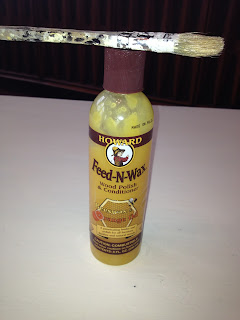Whenever I am in a creative slump, I end up doing some sort of creative project around my house that gets the excitement and ideas flowing again....and this month, I decided to do an antique redo of my coffee and end table in my living room. My friend told me about the amazing qualities of chalk paint (not to be confused with chalk board paint), by Annie Sloan, and in doing more research, I also found another antique-type paint called Milk Paint. It's actually the type of paint people used to white wash fences or paint walls before all of the new latex and commercial paints were on the market. I love the fact that it's virtually zero VOC, natural paint that uses none other than milk and hydrated lime! So, I wasn't set on using milk paint over chalk paint, but when I visited my local antique market last week, I saw that they carried milk paint, so I just had to buy it! I bought a creamy color, as well as a bonding agent to help the milk paint adhere to my already painted surface. Yeah, milk paint will stick like a stain to unfinished wood, but if your piece is already stained, painted, poly'd, etc., you may need to add the bonding agent to your milk paint to keep it from totally peeling off.
About that peeling....milk paint will give an authentic antique look because it chips off the surface of finished or painted objects. It is unpredictable, so there is a partial gamble when you choose to use milk paint. I had to use the bonding agent because I had painted my coffee and end tables black. My goal was to have the black show through the spots that the creamy milk paint chipped off.
Here is my milk paint:
Milk paint comes in a powder form that you mix with water. It's perishable because it's, yanno; made with milk. The best part is that you can mix a little at a time, so you can make your milk paint last a long time!
Here is my project: black end and coffee tables that were originally oak or something like that. :) These were college hand- me- downs so I've never been afraid to "play" with them...before the black, I had painted some swirly floral pattern on it in college. And, now they are onto a new phase of life- antique cream.
There isn't a need to sand with milk paint, but I did use the bonding agent since my surface had been painted first. Here is the table after the first coat...pretty streaky, but that's normal. You can also see all the funky distressing in the wood courtesy of my 3 and 5 year old over the years. at least it fits the antique look!
Covering this black took more coats than I anticipated. I could have actually done another coat, but after a second trip to the antique store to buy another pint of paint, I made the executive decision that three would have to do. If you aren't covering a dark surface, or you're using a darker color milk paint, one or two coats usually does the trick. After it was completely dry (2-3 hours after it's painted), I sanded with pretty gritty paper, as well as scraped very lightly with a putty knife along the edges, and anywhere that kind of "bubbled" up. This bubbling where the paint doesn't adhere to the surface is what gives you the chippy look. Unfortunately....wait for it...I had a major craftastrophy. I made the mistake of not sanding my end table before I painted it black. So, even though I used the bonding agent in the milk paint, (which stuck beautifully to the black paint), it unfortunately pulled the black paint away from the wood. This is what happened:
I scratched as much paint off as I could, sanded the entire thing till I broke a sweat, and made yet another executive decision (that I half way regret now) to not repaint it black, but to just paint it with the milk paint. I didn't want to have to buy more milk paint for this project, and I was running short on the amount of time I could stay sane with a torn apart living room. That reason is enough for me not to care that it doesn't have black like the awesome coffee table, and it still looks cool. So, here they are; painted and sanded, looking all antiquely amazing.
Last step: waxing. Waxing protects the milk paint similarly to a polyurethane. You can use dark waxes to add more drama to your pieces, especially those with intricate woodworking details. I wanted to keep my furniture light, so I used this nice beeswax with orange oil. Again, a low chemical formula, so I could feel good about using it in my home and not use a gas mask. :) It intensifies the colors beautifully without actually changing the color. I did 2 coats of wax, letting them dry between coats, and three coats on just the top of the coffee table since it gets so much abuse.
Here is the *almost* finished living room! I still need an area rug, and a few other things...but I do love the new look with the lighter tables. There was too much black before!
What's inspiring you these days??
Happy Crafting!!!
Love,
Anna










